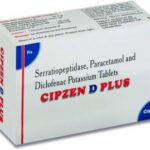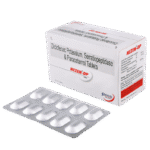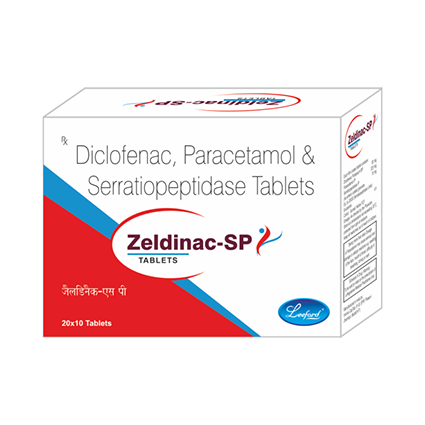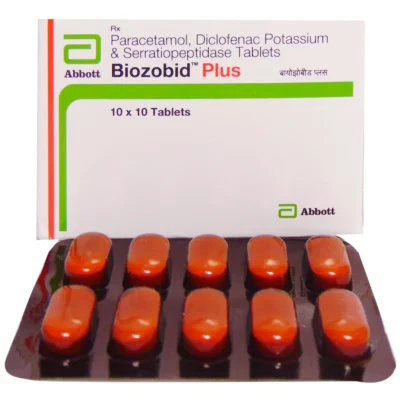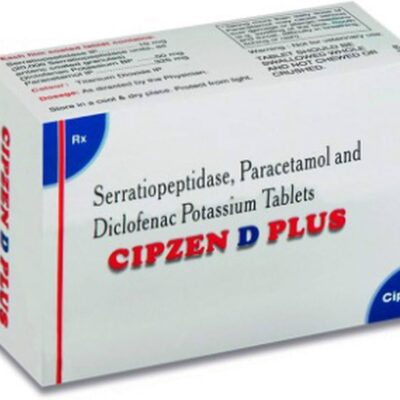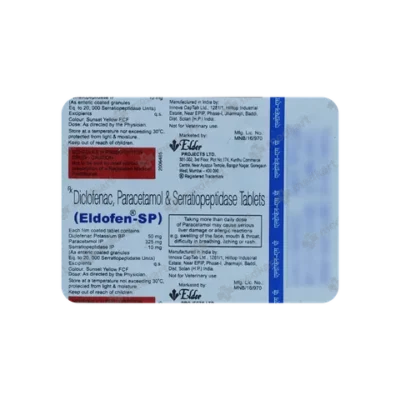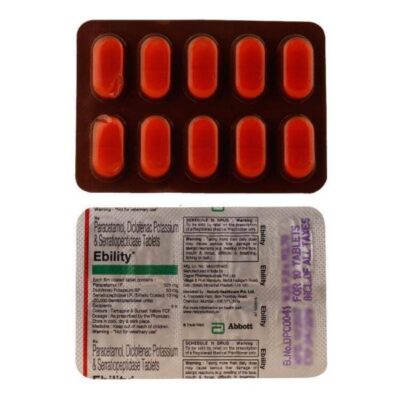Description
💊🔥 Triple Action Pain Relief: Diclofenac 50mg + Paracetamol 325mg + Serratiopeptidase 10mg
🧾 Overview
This combination medication of Diclofenac, Paracetamol (Acetaminophen), and Serratiopeptidase is used to manage acute pain, inflammation, and swelling in conditions such as:
-
Musculoskeletal injuries (sprains, strains)
-
Dental pain
-
Post-surgical inflammation
-
Arthritis and spondylitis
-
ENT inflammation (e.g., sinusitis, tonsillitis)
Each component has a specific role:
-
Diclofenac: Non-steroidal anti-inflammatory drug (NSAID)
-
Paracetamol: Analgesic and antipyretic (fever reducer)
-
Serratiopeptidase: Enzyme that reduces swelling and improves healing
🔬 How Each Ingredient Works
-
Diclofenac (50 mg)
Reduces inflammation and pain by inhibiting prostaglandins (chemicals involved in inflammation). -
Paracetamol (325 mg)
Provides pain relief and reduces fever by acting on the hypothalamus and prostaglandin pathways. -
Serratiopeptidase (10 mg)
Breaks down inflammatory proteins and helps reduce swelling, bruising, and fluid retention at injury sites.
💊 How to Use
-
Dosage: Typically 1 tablet 2–3 times a day, after meals (as prescribed)
-
Route: Oral
-
Duration: Short-term use (5–7 days recommended unless directed by physician)
-
Important: Do not exceed 4 g of Paracetamol per day (from all sources)
😕 Common Side Effects
-
Gastrointestinal discomfort: Nausea, acidity, bloating, or indigestion
-
Headache
-
Dizziness or light-headedness
-
Mild diarrhea (due to enzyme action)
-
Loss of appetite
These are usually mild and resolve with continued use or dose adjustment.
🚨 Serious Side Effects (Seek Immediate Attention)
-
Gastrointestinal bleeding or ulcers: Black stools, abdominal pain, vomiting blood
-
Liver toxicity (mainly from Paracetamol overdose): Yellowing of skin/eyes, fatigue, dark urine
-
Kidney dysfunction: Reduced urine output, swelling in legs
-
Severe allergic reaction: Rash, itching, facial swelling, difficulty breathing
-
Blood disorders (rare): Easy bruising, unusual bleeding
🩺 Monitoring & Follow-Up
-
Liver function tests (LFTs): For those using it more than a few days or with liver disease
-
Kidney function tests (RFTs): Especially in elderly or dehydrated patients
-
Gastrointestinal monitoring: For patients with a history of ulcers
-
Regular pain assessment: To evaluate need for continued therapy
⚠️ Warnings & Precautions
-
Avoid in:
-
Active peptic ulcer or GI bleeding
-
Severe liver or kidney disease
-
Hypersensitivity to NSAIDs or Paracetamol
-
-
Use with caution in:
-
Patients on anticoagulants (e.g., warfarin)
-
Asthmatics (may worsen symptoms)
-
Pregnant women (especially in the third trimester)
-
Chronic alcohol users (increased liver toxicity risk)
-
-
Drug Interactions:
-
Other NSAIDs
-
Blood thinners
-
Methotrexate
-
Lithium
-
-
Do not combine with alcohol – increases liver risk
✅ Summary
Diclofenac + Paracetamol + Serratiopeptidase offers effective multi-targeted pain relief, addressing inflammation, pain, and swelling in acute conditions. It is especially useful for traumatic injuries, post-operative care, and inflammatory joint disorders. While effective, short-term use is advised to minimize risks like gastric ulcers or liver damage. Always take under medical supervision with appropriate monitoring.
Consult your doctor before use and never self-medicate.
Note: This information is intended for educational purposes and should not replace professional medical advice. Always consult a healthcare provider for personalized guidance.
